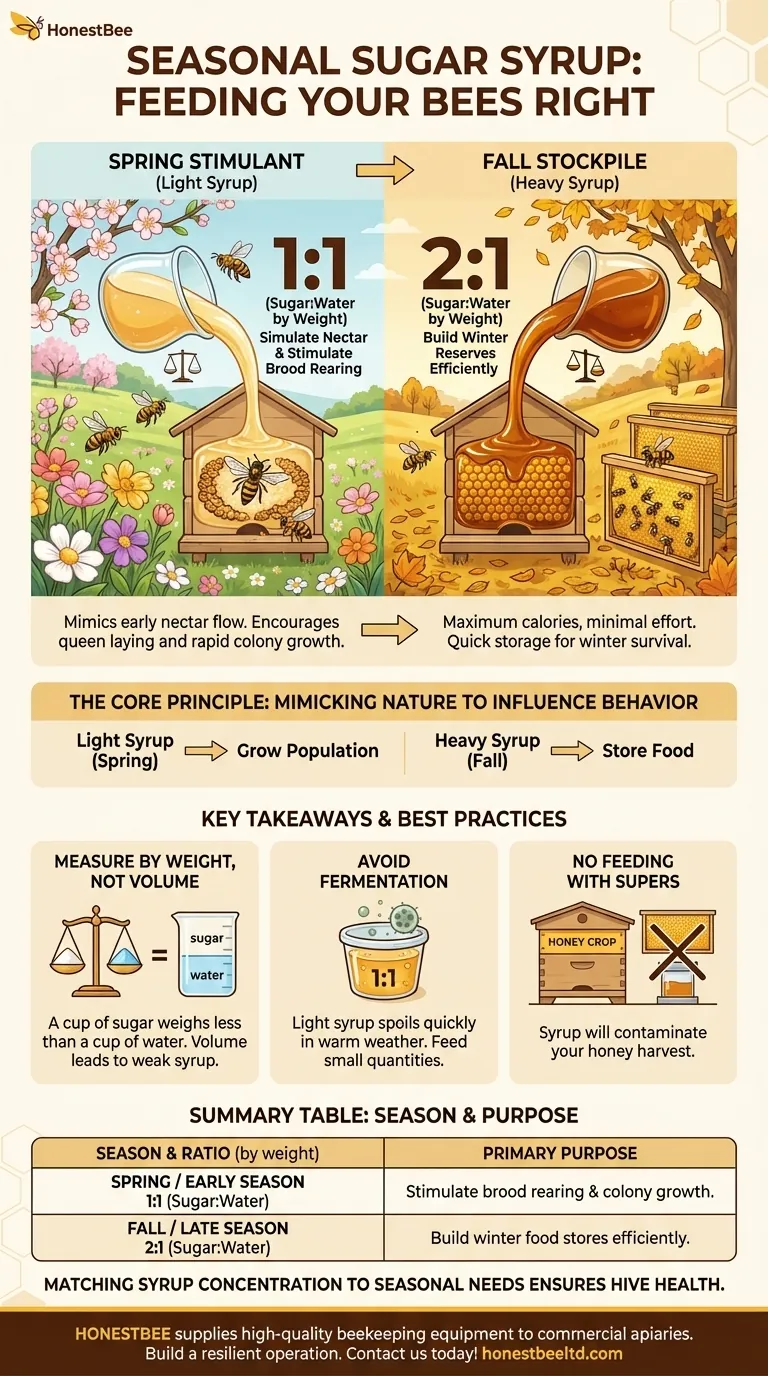The correct sugar syrup ratio for your bees depends entirely on the season and your colony's needs. In the fall, beekeepers typically use a heavy 2:1 syrup (two parts sugar to one part water, by weight) to help bees build winter stores. Conversely, in the late winter or early spring, a light 1:1 syrup is used to simulate nectar flow and stimulate brood rearing.
The core principle is simple: you are mimicking nature to influence colony behavior. Light syrup tells the bees it's time to grow the population, while heavy syrup signals it's time to store food for winter survival.

The Two Primary Syrup Ratios Explained
Understanding the purpose behind each syrup ratio is the key to supporting your colony effectively. Each concentration serves a distinct biological purpose within the hive.
The Spring Stimulant: 1:1 Syrup (Light Syrup)
This mixture is an equal ratio of sugar to water by weight. It is often referred to as a "stimulative" feeding.
The primary purpose of 1:1 syrup is to simulate an early spring nectar flow. This incoming "nectar" encourages the queen to begin laying eggs and prompts the colony to expand its brood nest.
It provides easy-to-process energy that fuels the colony's rapid growth phase as they prepare for the main honey season.
The Fall Stockpile: 2:1 Syrup (Heavy Syrup)
This is a dense mixture of two parts sugar to one part water by weight. This syrup is meant for building winter reserves.
Its high sugar concentration provides maximum calories with minimal effort for the bees. They can quickly process and store this dense syrup in the comb.
Because it requires less water to be evaporated by the bees, it is an efficient way for them to build the food stores they will depend on to survive the cold winter months.
Why the Concentration Matters: Mimicking Nature
The decision to use light or heavy syrup goes beyond simple feeding. You are providing specific signals to the colony that guide their collective behavior.
Simulating Nectar Flow
The 1:1 ratio closely resembles the sugar concentration of the nectar found in early spring blossoms. This familiar signal triggers the bees' instinct to expand.
The 2:1 ratio does not mimic a specific nectar source. Instead, it acts as a highly efficient food source that allows bees to rapidly gain weight and stockpile resources before the dearth of winter.
Influencing Colony Behavior
Feeding light 1:1 syrup tells the colony that resources are plentiful and it's time to invest in raising a new generation of bees.
Feeding heavy 2:1 syrup sends a different message: "winter is coming." The colony's focus shifts from brood rearing to the urgent task of storing food.
Understanding the Trade-offs and Best Practices
While feeding is a powerful tool, it must be used correctly to avoid creating new problems for the hive.
The Importance of Measuring by Weight
The standard 1:1 and 2:1 ratios are universally understood to be based on weight, not volume. A cup of granulated sugar weighs significantly less than a cup of water, so measuring by volume will result in a much weaker syrup than intended.
When to Avoid Feeding
Never feed syrup when you have honey supers on the hive that you intend to harvest. The bees will store the sugar syrup in the comb, contaminating your honey crop. Feeding is for supporting the bees, not for creating "honey."
Preventing Fermentation
Light 1:1 syrup can ferment quickly, especially in warm weather. It's best to provide it in smaller quantities that the bees can consume within a few days to prevent it from spoiling. Heavy 2:1 syrup is much more stable due to its high sugar content.
Making the Right Choice for Your Colony
Ultimately, your feeding strategy should be a direct response to your colony's needs and the time of year.
- If your primary focus is stimulating spring growth: Use a 1:1 syrup to encourage the queen to lay and the colony to expand its population.
- If your primary focus is preparing the colony for winter: Use a 2:1 syrup after the final honey harvest to ensure they have adequate food stores.
- If your primary focus is saving a weak or new colony: A 1:1 syrup is generally easier for a small colony to consume and process, providing immediate energy.
By matching your syrup concentration to the seasonal needs of your hive, you provide the precise support your bees need to thrive.
Summary Table:
| Season | Syrup Ratio (by weight) | Primary Purpose |
|---|---|---|
| Spring / Early Season | 1:1 (Sugar:Water) | Stimulate brood rearing & colony growth |
| Fall / Late Season | 2:1 (Sugar:Water) | Build winter food stores efficiently |
Ensure your apiary has the right equipment for successful feeding seasons. HONESTBEE supplies durable, high-quality beekeeping supplies and equipment to commercial apiaries and distributors through wholesale-focused operations. Let us help you build a more resilient and productive operation. Contact our team today to discuss your needs and request a wholesale catalog!
Visual Guide

Related Products
- HONESTBEE Professional Hive Top Bee Feeder Feeding Solution
- HONESTBEE Round Hive Top Bee Feeder for Syrup
- HONESTBEE Entrance Bee Feeder Professional Hive Nutrition Solution for Beekeeping
- Classic Boardman Entrance Bee Feeder Hive Front Feeding Solution
- Rapid Bee Feeder White Plastic 2L Round Top Feeder for 8 or 10-Frame Bee Hives
People Also Ask
- Do I need an inner cover with a hive top feeder? Optimize Your Hive Setup for Healthy Bees
- What features make top feeders a reliable choice for beekeepers? A Guide to Safe, Efficient Hive Nutrition
- What should be done with feeders and equipment after feeding bees? Essential Steps for Apiary Health
- How do I keep bees from drowning in my top feeder? Ensure Safe Feeding for Your Hive
- How is the plywood floor fitted into the hive-top feeder? Ensure Longevity with a Floating Floor Design



















